
Robinia pseudoacacia, commonly known in its native territory as black locust, is a medium-sized hardwood deciduous tree, belonging to the tribe Robinieae of the legume family Fabaceae. It is native to a few small areas of the United States, but it has been widely planted and naturalized elsewhere in temperate North America, Europe, Southern Africa and Asia and is considered an invasive species in some areas, such as the temperate east coast of Australia where the cultivar 'Frisia'(Golden Robinia) was widely planted as a street tree before being classed as a weed. Another common name is false acacia, a literal translation of the specific name.

Robinia is a genus of flowering plants in the family Fabaceae, tribe Robinieae, native to North America. Commonly known as locusts, they are deciduous trees and shrubs growing 4–25 metres (13–82 ft) tall. The leaves are pinnate with 7–21 oval leaflets. The flowers are white or pink, in usually pendulous racemes. Many species have thorny shoots, and several have sticky hairs on the shoots.
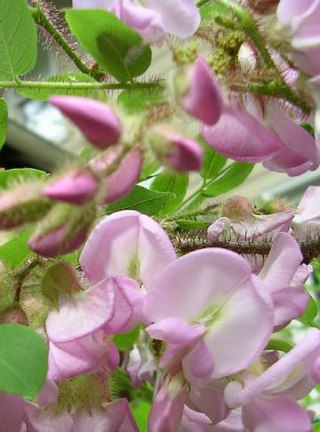
Robinia hispida, known as the bristly locust, rose-acacia, or moss locust, is a shrub in the subfamily Faboideae of the pea family Fabaceae. It is native to the southeastern United States, and it is present in other areas, including other regions of North America, as an introduced species. It is grown as an ornamental and can escape cultivation and grow in the wild.

The buff-tip is a moth of the family Notodontidae. It is found throughout Europe and in Asia to eastern Siberia. The species was first described by Carl Linnaeus in his 1758 10th edition of Systema Naturae.

Macrosaccus robiniella is a moth of the family Gracillariidae.

Esperia oliviella is a species of gelechioid moth.

Euparthenos is a monotypic moth genus in the family Erebidae erected by Augustus Radcliffe Grote in 1876. Its only species, Euparthenos nubilis, the locust underwing, was first described by Jacob Hübner in 1823. The adults resemble some of the underwing moths of genus Catocala, which are fairly close relatives, in color, pattern, and the habit of resting on tree trunks. But E. nubilis can usually be immediately recognized by the four concentric black bands per hindwing, as opposed to one or two in Catocala. Color morphs of E. nubilis with altered pattern are known, however, and these may be hard to recognize without detailed examination.

Automeris zozine is a moth of the family Saturniidae. It is found in Mexico, south to Guatemala and Colombia.

Honey production in Hungary plays an important role in food supply and also in terms of local industry within the country. Hungary is one of the European Union's largest producers of natural honey, amounting to 19.7 thousand tonnes of production in 2005.
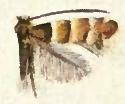
Chrysaster ostensackenella is a moth of the family Gracillariidae. It is known from Ontario, Québec and Nova Scotia in Canada, and the United States. It has also been recorded in 2015 from China and in 2017 from Korea, and in 2022 from Central Italy.
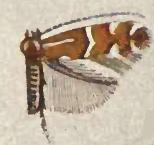
Phyllonorycter gemmea is a moth of the family Gracillariidae. It is known from Massachusetts and Maine in the United States.
Parectopa lespedezaefoliella is a moth of the family Gracillariidae. It is known from Québec, Canada, and Maine, Pennsylvania, North Carolina and Michigan in the United States.
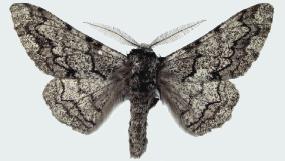
Biston robustum is a species of moth belonging to the family Geometridae. This is a large moth and is known in its native range as the giant geometer moth. It is related, and generally similar, to the famous and widespread Peppered Moth.
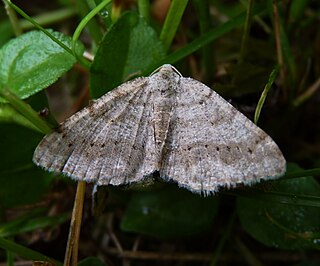
Digrammia ocellinata, the faint-spotted angle or locust looper, is a moth of the family Geometridae. The species was first described by Achille Guenée in 1857. It is found in the eastern United States, Quebec and Ontario.

Sciota subcaesiella, the locust leafroller moth, is a species of moth of the family Pyralidae. It is found in North America, including Maryland, New Jersey, Oklahoma, Iowa, North Carolina, South Carolina, Georgia, Alabama, Mississippi, Maine, New Hampshire, New York, Massachusetts, Pennsylvania, the District of Columbia, Virginia, Tennessee, Illinois, Missouri, Arkansas, Nova Scotia and Ontario.
Lapiș Forest nature reserve IUCN category IV, is located in northwestern Romania, in the west of Sălaj County, near the village of Nușfalău, which is about 9 km from Șimleu Silvaniei.

Heliomata cycladata, the common spring moth, is a moth of the family Geometridae. The species was first described by Augustus Radcliffe Grote and Coleman Townsend Robinson in 1866. It is found in eastern North America, with records from southern Ontario, southern Quebec, Maine, New Hampshire, Michigan, Wisconsin to South Carolina, Georgia, Alabama, northern Mississippi and Arkansas.

Aroga trialbamaculella, the red-striped fireworm moth, is a moth of the family Gelechiidae. It is found in the United States, where it has been recorded from Maine to Florida and from Illinois to Texas.

Gymnandrosoma punctidiscanum, the dotted ecdytolopha moth, is a moth of the family Tortricidae. It is found in North America, where it has been recorded from Alabama, Arkansas, Florida, Georgia, Illinois, Indiana, Kentucky, Maine, Maryland, Massachusetts, Michigan, Minnesota, Missouri, New Jersey, New York, North Carolina, Ohio, Oklahoma, Ontario, Pennsylvania, Quebec, South Carolina, Tennessee, Virginia, and West Virginia.

Herophila tristis is a species of beetle in the family Cerambycidae, they are also called longhorned beetles. It was described by Carl Linnaeus in 1767, originally under the genus Cerambyx. It is known from Italy, Romania, Austria, Bulgaria, Crete, Croatia, Sardinia, France, Greece, Serbia, Corsica, Sicily, Hungary, Slovenia, Albania, and Turkey. It feeds on Morus alba, Ficus carica, and Robinia pseudoacacia. They live 2–3 years and are 13–26 mm long. Larvae feed under the bark of a range of broad-leaved trees, mostly Ficus carica commonly known as fig trees. As an adult they hide in the day and come out in the dusk.
















